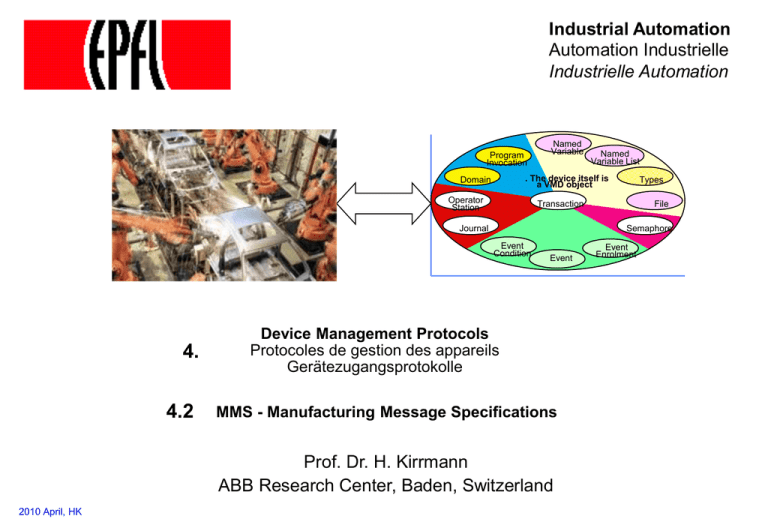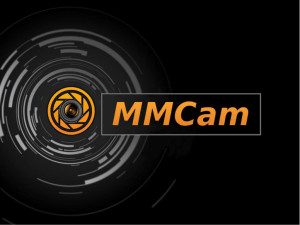Manufacturing Messaging Specification (MMS)
advertisement

Industrial Automation
Automation Industrielle
Industrielle Automation
Program
Invocation
Named
Variable
. The device itself is
a VMD object
Domain
Operator
Station
Event
Action
Device Management Protocols
Protocoles de gestion des appareils
Gerätezugangsprotokolle
MMS - Manufacturing Message Specifications
Prof. Dr. H. Kirrmann
ABB Research Center, Baden, Switzerland
2010 April, HK
File
Semaphore
Event
Condition
4.2
Types
Transaction
Journal
4.
Named
Variable List
Event
Enrolment
MMS Application domain
cell
Industrial Automation
controller
Manufacturing Message Specification 4.2 -2
Interaction between Operator Workplace and field equipment
SCADA (client)
(any technology)
request message
response message
network
(any)
controller (server)
(any technology)
represents automation objects,
i.e. a collection of PLC1 variables
manufacturing devices
represent pieces of equipment
MMS: we want to access all controllers, regardless of the manufacturer, in the same way.
1: PLC= Programmable Logic Controller
Industrial Automation
Manufacturing Message Specification 4.2 -3
The basic MMS idea: read a variable
client
(any technology)
request
read
response
variable name
value
status
network
(any)
server
I / O devices
basic MMS idea: read and write equipment variables using standard messages.
Industrial Automation
Manufacturing Message Specification 4.2 -4
Application: MMS for OPC
operator
(client)
OPC uses MMS
for variable
access, (events)
historian
client
other
clients
OPC will be
detailed in
chapter 4.3
OPCserver
MMS client
MMS accesses PLC
Variables
TCP/IP
Ethernet
Ethernet
AC800
TCP/IP
MMS
server
PLC variables
Ethernet
TCP/IP
MMS
server
MMS
client
PLC variables
S7
Ethernet
TSX
TCP/IP
MMS MMS
server client
PLC variables
intention: any PLC should be accessed that way (MMS as universal server)
Industrial Automation
Manufacturing Message Specification 4.2 -5
MMS - Manufacturing Message Specification history
Developed 1980 (!) for the MAP project (General Motor’s flexible manufacturing initiative)
Originally unluckily tied to the OSI communication stack and Token Bus (IEEE 802.4)
Reputed for being heavy, complicated and costly due to poor implementations.
Boeing adopted MMS as TOPs (MMS on Ethernet) - a wise step.
Adopted by the automobile industry, aerospace industry, and PLC manufacturers:
Siemens, Schneider, Daimler, ABB.
Standardized since 1990 as:
[1]
ISO/IEC 9506-1 (2003): Industrial Automation systems Manufacturing Message Specification Part 1: Service Definition
[2]
ISO/IEC 9506-2 (2003): Industrial Automation systems Manufacturing Message Specification Part 2: Protocol Specification
Industrial Automation
Manufacturing Message Specification 4.2 -6
MMS - Concept
MMS (Manufacturing Message Specifications) defines:
• A set of standard objects which must exist in every conformant device, on which
operations can be executed (examples: read and write local variables, signal events...)
• A set of standard messages exchanged between a client and a server station
for the purpose of controlling these objects
• A set of encoding rules for these messages (how values and parameters are
mapped to bits and bytes when transmitted)
• A set of protocols (rules for exchanging messages between devices)
MMS does not specify application-specific operations (e.g. change motor speed).
This is covered by application-specific, “companion standards”
(e.g. flexible manufacturing, drives, remote meter reading, ...)
Industrial Automation
Manufacturing Message Specification 4.2 -7
MMS - Communication model
MMS does not specify
the application interface
remote
procedure
call interface
device
(e.g. PC)
device
(e.g. SCADA)
MMS specifies a set
of messages which
allow an MMS client
to control an MMS
server
MMS specifies the
class of objects that
an MMS server is
expected to hold
MMS
client
request
MMS
server
response
(command)
(reply)
communication
stack
switch
Industrial Automation
MMS specifies how
messages are
encoded for
transmission
network
communication
stack
router
Manufacturing Message Specification 4.2 -8
MMS mapping to communication
MMS is not by itself a communication protocol, it defines messages that have
to be transported by an unspecified network
Industrial Automation
Manufacturing Message Specification 4.2 -9
MMS - Underlying Communication Principles
MMS is in principle independent from the communication stack.
MMS only requires that two types of communication services exist:
MMS Client
MMS Server
network
Request
Indication
1) Remote Procedure Call
(Call paired with Reply,
synchronous, unicast)
processing
Confirmation
Response
time
2) Event Reporting
(spontaneous messages sent
by server)
event
Request
Indication
Industrial Automation
Manufacturing Message Specification 4.2 -10
Current MMS Stack
MMS
Association Control Service Element, ACSE, ISO 8649/8650, N2526,N2327
“Application”
Abstract Syntax Notation, ISO 8822/8823, 8824/8825
Presentation
ISO 8326/8327
RFC 1006
TCP
IP
void (EtherType)
ISO 8802-3
(Ethernet)
Session
Transport
Network
Link
MAC
Physical
Some manufacturers omit the ISO upper layers, makes it much simpler, but non-standard...
Industrial Automation
Manufacturing Message Specification 4.2 -11
MMS in the fieldbus stack
time-critical
applications
(PLC tasks)
time-benign
applications
(HMI, download)
real-time
data base
Management
Interface
time-benign
messages
time-critical
process variables
MMS
7
Application (Association)
6
Presentation
Remote Procedure Call
5
Session
connection-oriented
4
Transport (connection-oriented)
3
Network (connectionless)
2"
Logical Link Control
medium access
2'
Link (Medium Access)
media
1
Physical
implicit
implicit (ASN.1)
real-time
traffic (not MMS)
connectionless
connectionless
common
MMS is not for real-time communication, but it can access the real-time variables
Industrial Automation
Manufacturing Message Specification 4.2 -12
MMS Objects
Each MMS server is expected to contain a number of standard objects
Industrial Automation
Manufacturing Message Specification 4.2 -13
MMS - Concept of Virtual Manufacturing Device (VMD)
robot
flow meter
A virtual device
represents a
(complex) piece of
equipment
cell
Virtual
Device
MMS client
connection
establishment
Virtual
Device
Application Programming Interface
(MMSI = MMS interface)
ACSE
ACSE
presentation
presentation
session
transport
session
transport
network
link
network
link
physical
physical
Industrial Automation
Virtual
Device
communication
stack
Application-specific
object models
MMS messages
A physical device
(PLC) may
implement one or
more virtual
devices
Manufacturing Message Specification 4.2 -14
MMS - Objects in a PLC device
memory regions
upload / download
tasks
PLC
program
invocations
domains
remote control the
PLC
keep track of
history
initiate
start/stop
semaphores
identification
Journal
if mass storage
available
Files
variables
named
variables
variable
lists
user-defined
variables
local HumanMachine
Interface
Operator
Station
events
events
& alarms
state machines for
alarms and events
groups of variables
Industrial Automation
Manufacturing Message Specification 4.2 -15
MMS – Object Name
All objects are identified by an object name, that may be
- [0] VMD - specific
persistent, pre-loaded, all clients see the same
“VMDstatus"
- [1] Domain -specific
exists as long as the corresponding domain*
"e.g. { “Domain1”, “Valve3.Position“}
- [2] Application-Association specific exists as long as the client remains connected,
applies to non-persistent objects such as data
sets that the client created
“@/MyDataSet”
The identifier itself is a "visible string“ (e.g. “Call.Robot1.Joint3.Pos”).
Access to all objects can be controlled by a special object, the Access Control List
that tells which client can delete or modify the object.
The service GetNameList retrieves the name and type of all named objects in the VMD.
(directory service)
* a domain is a (named) memory region that contains programs, variables, data
Industrial Automation
Manufacturing Message Specification 4.2 -16
MMS - Initialisation
An MMS client establishes first an Association (connection) with an MMS Server
A server may sustain several simultaneous associations with different clients
(to synchronize access, MMS provides semaphores)
At initialisation time, the client lists the capabilities it expects and the server responds
with the capabilities it offers.
The capabilities are defined by Conformance Building Block parameters.
e.g. cto CBB means that the server agreed to provide an Access Control List
initialisation services:
Initiate
ConcludeAbort
Reject
Cancel
Status
GetCapabilityList
GetNameList
Rename
Industrial Automation
Identify
Manufacturing Message Specification 4.2 -17
MMS – Association establishment
MMS Requester
(Requesting MMS-user)
Request
Confirmation
M_Associate_Req(
MMS_responder_address,
calling_application_reference,
called_application_reference,
communication_parameters,
authentication,..
MMS Responder
(Receiving MMS-user)
Indication
Response
M_Associate_Ind(
MMS_responder_address,
calling_application_reference,
called_application_reference,
communication_parameters,
authentication,..
this is no application interface, but a short way to describe the messages exchanged
Industrial Automation
Manufacturing Message Specification 4.2 -18
MMS connection establishment and release
MMS Client
MMS Server
network
Associate
Indication
accept
Confirmation
Response
Request
repeat
indefinitely
in any order
on demand
Response
Confirmation
Indication
spontaneous
Release
Confirm
how the association is set up is beyond the scope of MMS (it depends on the stack)
Industrial Automation
Manufacturing Message Specification 4.2 -19
MMS - Addressing
MMS does not specify how to address clients and servers.
Messages contain only a communication reference
(number which identifies the connection)
obtained by unspecified means.
In practice, clients and servers are addressed by their IP address
and the MMS server uses port number 102.
Industrial Automation
Manufacturing Message Specification 4.2 -20
MMS services
The most important services are:
-Variables,
-Domains,
-Program invocations
-Events,
for the other services, see the ISO / IEC standard 9506
Industrial Automation
Manufacturing Message Specification 4.2 -21
MMS Variables Service
Variables are the most important object type in MMS.
Through this service, a client can read and write local variables in a remote device.
Variables can be read or written as individual variables or better as lists.
A Variable is characterized by:
- its Name
- its Data Type
- its attributes:
-MMS deletable (access to the variable can be deleted by the
-Access method (public,..)
Industrial Automation
Manufacturing Message Specification 4.2 -22
MMS Variables service - reading
MMS client process database
(cache)
MMS client
MMS server
MMS client
MMS server
MMS server
MMS client
MMS server
VMD
process database
1) Polling:
a) the bus scans periodically the variables and actualises the local databases
b) the Operator Workstation polls cyclically the variables it is interested in
2) Events:
a) the Controllers signal predefined events and broadcasts the corresponding values
b) the Operator Workstation defines the relevant events and their destination(s)
Industrial Automation
Manufacturing Message Specification 4.2 -23
MMS Variables service - Mapping named to unnamed variables within a PLC
Program 1
Program 2
Program 3
variables data repository
The MMS server
accesses the PLC
variables through the
Vput and Vget
functions, which are
outside the scope of
the standard.
Vput
MMS
server
Industrial Automation
Vget
Variables
Services
communication
stack
presentation
session
transport
network
link
physical
ACSE
Read
Write
InformationReport
GetVariableAccessAttributes
DefineNamedVariables
DefineNamedVariableList
DefineNamedType
GetNamedVariableListAttributes
GetNamedTypeAttributes
DeleteNamedVariableList
DeleteVaraibleAccess
DeleteNamedType
Manufacturing Message Specification 4.2 -24
MMS Variables service - Usage of Named and Unnamed variables
automation
application
controller
programming
Get (192.162.0.2), MW%1003)
symbols
code
Reactor_1.Program2
phy. address symbol
MW%1003
MotorSpeed
MW%1004
…
Temperature
….
Return (192.162.0.0), MW%1003, 112)
download
code
MMS
client
MMS
client
download
symbol table
The code generator's linker
knows the physical address of the
variables in the PLC and their symbol
network
MMS
server
Marker: MW%1003
analog input to : IXD.11.2.1
if the name server is not aware of
the variable's symbol, the MMS
client must have access to the
programmer's symbol files
unnamed variables require a client's a-priori
knowledge of the internal structure of the server
Industrial Automation
Manufacturing Message Specification 4.2 -25
MMS Variables service - Variable Lists
MMS provides services to build a Data Set, a group of variables that is to be
transmitted as a whole.
This is generally done for each client specifically (Application-Association specific)
The client defines a list and populates it with the names of the variables and the
transmission mode
Industrial Automation
Manufacturing Message Specification 4.2 -26
MMS Variable Service – Summary
Read
Write
InformationReport(optional)
GetVariableAccessAttributes
DefineNamedVariable
DeleteVariableAccess
read a remote variable
write a remote variable
spontaneous send the value to a client
get the attributes of the variable
assigns named variable to an unnamed & type
DefineNamedVariableList
defines lists of variables
GetNamedVariableListAttributes
(Read)
for individual variables or lists
(Write)
(Information Report)
DeleteNamedVariableList
DefineNamedType
GetNamedTypeAttributes
DeleteNamedType
defines the types
DefineScatteredAccess
GetScatteredAccessAttributes
defines variables group treated as a whole
(obsolete, but useful)
Industrial Automation
Manufacturing Message Specification 4.2 -27
MMS Domains Service
Domains are named memory regions, for the purpose of downloading
and uploading large unstructured data such as program code.
Domain loading / uploading requires a special protocol because it can involve the
MMS driver itself or even the communication stack, and storing to stable storage.
Typically, a domain is loaded by segments of a size chosen by the receiver.
When a domain is loaded, it may be saved to EPROM (typical PLC programming).
Domains may be erased.
Objects (Variables, Events, Program invocations,..) may be tied to a domain.
Industrial Automation
Manufacturing Message Specification 4.2 -28
MMS Domain Service - State Diagram
Each domain is controlled by a state
machine in MMS.
This is necessary since a domain is
large and often needs to be loaded
in several steps.
Also, it may be necessary to write
the domain into a non-volatile
memory and that needs a tighter
control.
Industrial Automation
Manufacturing Message Specification 4.2 -29
MMS Domains Service - Summary
Operations on domains:
InitiateDownloadSequence
DownloadSegment
TerminateDownloadSequence
RequestDomainDownload
Download
InitiateUploadSequence
UploadSegment
TerminateUploadSequence
RequestDomainUpload
Upload
LoadDomainContent
StoreDomainContent
DeleteDomain
GetDomainAttributes
Industrial Automation
e.g. to EPROM
erase
Manufacturing Message Specification 4.2 -30
MMS Program invocations service
Program invocations are tasks running in the VMD.
Programs are tied to domains.
For instance, all tied programs are stopped before loading a domain containing them
CreateProgramInvocation
DeleteProgramInvocation
Start
Stop
Resume
Reset
Kill
GetProgramInvocationAttributes
Select
AlterProgramInvocationAttributes
ReconfigureProgramInvocation
Industrial Automation
Manufacturing Message Specification 4.2 -31
MMS Event services - principle
MMS provides services to:
- Event Condition (define the Boolean condition that triggers an event and its priority)
- Event Enrolment (define the MMS client(s) to notify when an event is triggered)
- Event Action (define the MMS confirmed service to be executed when the event occurs)
MMS client
enables/disables
event conditions
MMS client
MMS server
Event
Enrolment
Event
Condition
Event
Action
Who?
When?
What?
event notification
and confirmation
Events are the most complicated part of MMS
Industrial Automation
Manufacturing Message Specification 4.2 -32
MMS Event services - Event triggering
MMS client
MMS client
VMD
Network-triggered
Event
Enrolment
Event
Condition
boolean
variable
Event
Action
Monitored
cyclic monitoring
plant
events are triggered by a change in a boolean variable in the server (monitored event) or
by an MMS client (trigger event) as an invitation procedure.
Industrial Automation
Manufacturing Message Specification 4.2 -33
MMS Event services - Summary
The Event services are the most complicated part of MMS.
However, the event mechanism in a SCADA system is complex in nature.
Event Management
TriggerEvent
EventNotification
AcknowledgeEventNotification
GetAlarmSummary
GetAlarmEnrollmentSummary
Event Conditions
DefineEventCondition
DeleteEventCondition
GetEventConditionAttributes
ReportEventConditionStatus
AlterEventConditionMonitoring
Event Actions
DefineEventAction
DeleteEventAction
GetEventActionAttributes
ReportEventActionStatus
Industrial Automation
Event Conditions Lists
DefineEventConditionList
DeleteEventConditionList
AddEventConditionListReference
RemoveEventConditionListReference
GetEventConditionListAttributes
ReportEventConditionListStatus
AlterEventConditionListMonitoring
Event Enrollment
DefineEventEnrollment
DeleteEventEnrollment
GetEventEnrollmentAttributes
ReportEventEnrollmentStatus
AlterEventEnrollment service
Manufacturing Message Specification 4.2 -34
MMS - PDU Notation
MMS uses ASN.1 (ISO 8824) to describe the network messages (PDUs).
MMS specifies the use of BER (Basic Encoding Rules, ISO 8825) of ASN.1
(mandatory for connection establishment, but used in practice for all PDUs)
ObjectName ::= CHOICE {
vmd-specific
domain-specific
domainId
itemId
},
aa-specific
}
[0] Identifier,
[1] SEQUENCE {
Identifier,
Identifier
[2] Identifier
type
An identifier is a visible string
80 size
visible string
81 size 8A size
82 size
visible string
visible string
vmd-specific
8A size
visible string
domain-specific
aa-specific
This notation is quite heavy for simple variable transport (24 bits for one Boolean value)
but decoding costs must be weighted against communication costs.
Industrial Automation
Manufacturing Message Specification 4.2 -35
MMS - Importance
MMS has been during its 15 years of existence a reference model for industry
rather than an actual implementation.
Its high complexity makes it very general, but the requested bandwidth and computing
power were out of reach until few years ago.
It is - sometimes as a proprietary version - part of every PLC today.
It gave rise to several other "simpler" models (DLMS, BacNet, FMS....)
It is the base of IEC 61850 „Communication networks and systems in substations“, which
bases on TCP/IP/Ethernet
For more information, see:
http://lamspeople.epfl.ch/kirrmann/mms/
http://www.nettedautomation.com/qanda/mms/#OPC/MMS
EPRI = USA electrical power research institute
Industrial Automation
Manufacturing Message Specification 4.2 -36
Conclusion
Although MMS itself had little success (it is complicated), the concepts behind MMS have
inspired numerous other standards.
Industrial Communication protocols require a large bandwidth and a lot of
processing power at the servers, which is incompatible with low-cost, decentralized
periphery, but fully in line with the concept “Ethernet in the factory floor”.
While most field busses are able to connect relatively simple devices, the same is not true
for MMS and its derivatives.
The MMS concept is being challenged by OPC UA and by Web Services,
but these services will have to rediscover the semantics of MMS.
Industrial Automation
Manufacturing Message Specification 4.2 -37




